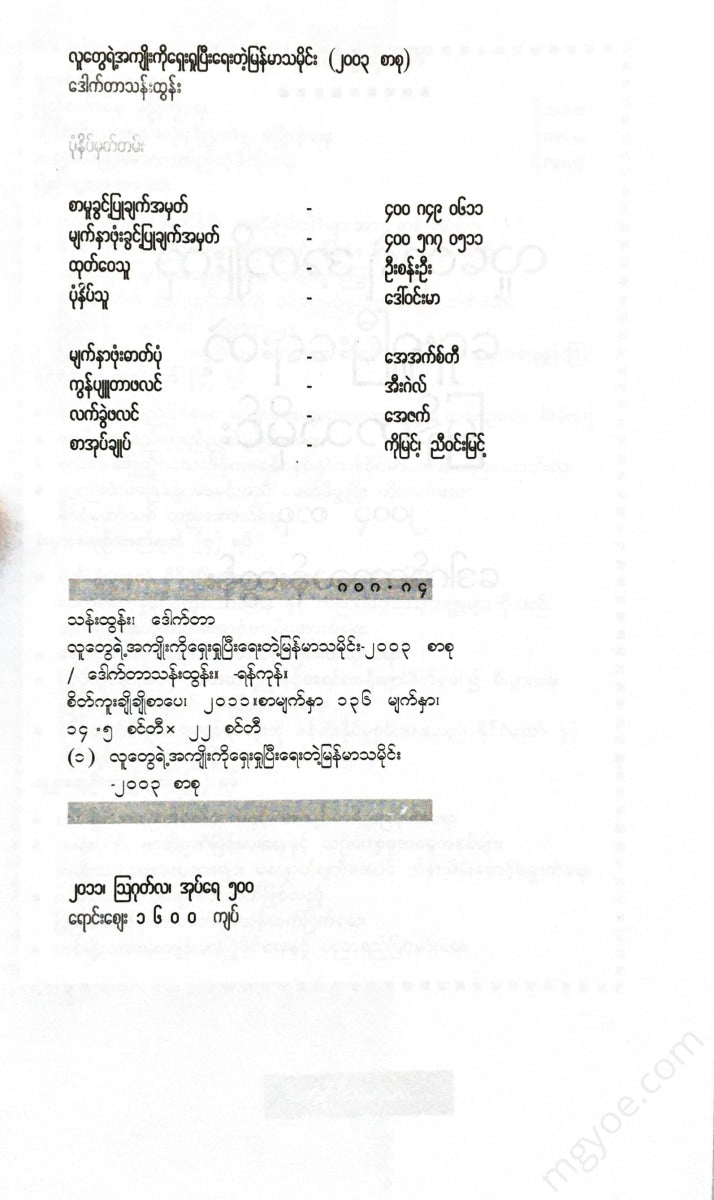စိတ်ကူးချိုချိုစာပေ
Dr. Than Tun - 2003 Collection of Myanmar History Written for the Benefit of the People
Dr. Than Tun - 2003 Collection of Myanmar History Written for the Benefit of the People
Couldn't load pickup availability
The last two kings of Nyaung-ran
During the reigns of King Sangma Sripavara Mahadhammarajadhipati (1714-1733) and King Sinku Mahadhammarajadhipati (1733-1752), they faced three unresolved issues: the Manipur Affair, the Hansawaddy Affair, and the Kui Affair. But the fundamental reason was the decline of their influence and the collapse of their administration at home.
When King Sangmu became king, his uncles, King Bagan and King Taungoo, rebelled. He sent 40 troops, 100 elephants, 1,000 horses, and 40,000 soldiers to suppress the rebels. King Bagan fled and King Taungoo surrendered.
One notable event during the reign of King Sangmu was the compilation of the Royal History by Maung Kala, the son of the Sintkai Thapa. He was praised for his excellent writing and clear Burmese language.
The king's good deeds
1. His father, King Sanemin (1698-1714), donated a golden pagoda and a golden umbrella to the pagoda built in Palepa. He also gave the title Lokman Aung.
2. In 1717, a monastery was built and dedicated to Sayadaw Gunawinda Rajaguru of Chindwin village.
3. In 1718, the U Nak Chaungna Pagoda and School, the Sagaing Shinhla Pyinsa Malin Pagoda and the three Harptans, the Lokadusa Mara Aung Pagoda, the Taung La Lone Tha Htun Oo Pagoda, and the Gandhamadana Taung Jotira Tha Man Aung Pagoda were built.
4. In 1720, a monastery was built and dedicated to the venerable Anandaja. A large, golden-glazed pagoda was built on the grounds of the famous Phyu Shin Hla Monastery.
5. In 1725, a large jade statue was carved at Sotapan, Sagaing River Port, and he was given the title of Lokama Aung.
6. In 1726, he installed the umbrella on the Great Pagoda of the city. He built the World Crown Pagoda.
7. In 1731, a large white crystal from Sakyin Mountain was carved into a statue and set in a brick and plaster.
8. 1732 The four-towered pagoda and the monastery were built south of the new palace. Completed
9. Every month of the month of Nayon, he held a quiz. If he could translate the grammar, the sāgaha, the yamaik, the padṇa, the āyā, and the tika, he was called the first to go. He included the relatives of the five-year-old ascetic in the horse-blood drinking group.
10. The three copies of the Pitaka were written in ink and placed in the Pitaka Temple for worship. -King Gara Nawas of Katha sent a message in 1723 asking for a daughter. He sent about 300 people to Ruwa in rafts to fetch the daughter.
The Katha king captured and killed the invaders. He also captured the city of Thaungthup. On 18 November 1724, King Sangma appointed the Pathanagori chieftain, Min Ye Thiha Kyaw, as his major and sent 50 elephants, 3,000 horses, and 30,000 soldiers. When Min Ye Thiha Kyaw said that he had crossed the Chindwin River, the Katha people fled from their towns and villages without putting up a defense. The soldiers were suffering from measles and measles on the rough road, so Min Ye Thiha Kyaw withdrew his army. The king was angry and said that he could not finish the war, so Min Ye Thiha Kyaw was punished.
During the reign of King Sungai, Zin Mae rebelled. In 1722, the governor of Zin Mae, Min Ye Nawrahta, his successor, Myay Nay Myin Nhu, and then Nanda Pat, “took bribes and tortured the Zin Mae people and their families,” and killed them and made Khana Dibba king. When King Sungai heard of the Zin Mae rebellion, on 30 September 1730, he appointed the new governor of the city, Min Ye Ranta, as a major and sent 17 troops, 50 elephants, 1,000 horses, and 10,000 soldiers. The Zin Mae people fortified the city, but they failed. In 1731, new troops were sent, but they were unsuccessful. From that time on, it became an independent country until the beginning of the Konbaung period. King Sungai died on 3 November 1733. His son Mahadhammaraja succeeded him as the king. The administration of the country was entrusted to the incompetent young teacher Rajananda, resulting in poor planning and poor governance.
It has been noted that the Supreme Commander, when giving gifts near and far, does not usually check the source of the gifts (Book, 2, 120).
He himself did not scrutinize and criticize the affairs of the country. He was more likely to indulge in entertainment and entertainment (Kone 1, 21).
At parties
In the month of Tagu, there is a water sprinkling ceremony and a New Year's dance performance, in the month of Kason, a water-pouring ceremony, in the month of Nayon, a ceremony for the examination of the merits in Waso, a lottery ceremony in Wakhaung, a boat festival in Taw Thalin, in the month of Thadingyut, a festival for the horse-riding procession and a festival for the gift-giving of Wakyut, in the month of Tasaungmone, a festival for the donation of Kathin robes, lotus robes, Tasaungdaing and the stars, in the month of Nattaw, an elephant festival, a horse-catching festival, in the month of Pyatho, a yagyu and bonfire festival in the month of Tapotwe, and a festival for the Buddha's festival in Tabaung. He lived in a state of joy and happiness. (Riri 1975, 22).
The weather in the country was bad, causing the farming industry to fail. Rice and paddy were scarce. The situation was at its worst in 1752.
January 2003, Kalya Magazine.

















